Abstract
1. Motoneurone death induced by axotomy in the rat was studied following section of the medial gastrocnemius nerve near the muscle 4 days after birth. 2. The maximum twitch tension of the medial gastrocnemius muscle achieved by motor reinnervation after section of its nerve was about 70% of that measured on the contralateral, intact side. 3. The number of motor units counted at 35-45 days of age in the animals whose medial gastrocnemius nerves had been sectioned on day 4 was 62% of that observed in normal rats. 4. The number of medial gastrocnemius motoneurones retrogradely labelled with horseradish peroxidase (HRP) 30-40 days after section of the medial gastrocnemius nerve was 77% of that labelled on the contralateral, intact side. 5. When the medial gastrocnemius nerve had been sectioned on day 4 and prevented from peripheral reinnervation, the number of medial gastrocnemius motoneurones labelled with HRP was, on the average, only 18% of that labelled on the control side. 6. Decreased number of medial gastrocnemius motoneurones labelled with HRP following prevention of peripheral reinnervation was associated with a decrease in the neurone density of the motor cell column, indicating the occurrence of motoneurone death. 7. The majority of medial gastrocnemius motoneurones axotomized 4 days after birth appear to maintain their survival for about 2 weeks without target contact. 8. The area of the compound action potential of medial gastrocnemius motor fibres once decreased after axotomy on day 4 began to recover from the 12th day after the operation if reinnervation by the cut peripheral nerve had been allowed, whereas the compound action potential continued to decrease in those axotomized motoneurones whose reinnervation had been prevented. 9. It is concluded that target dependence of motoneurone survival previously observed at embryonic stages is still present during the early post-natal period.
Full text
PDF
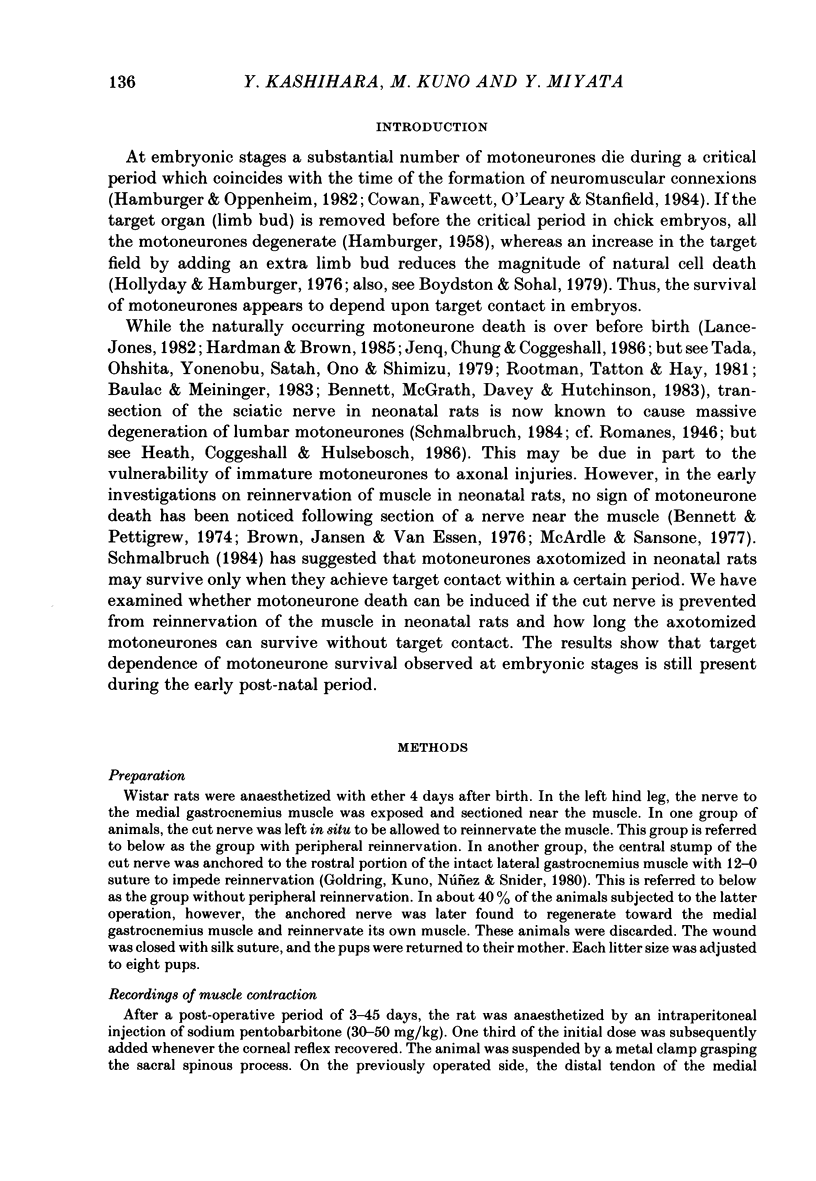
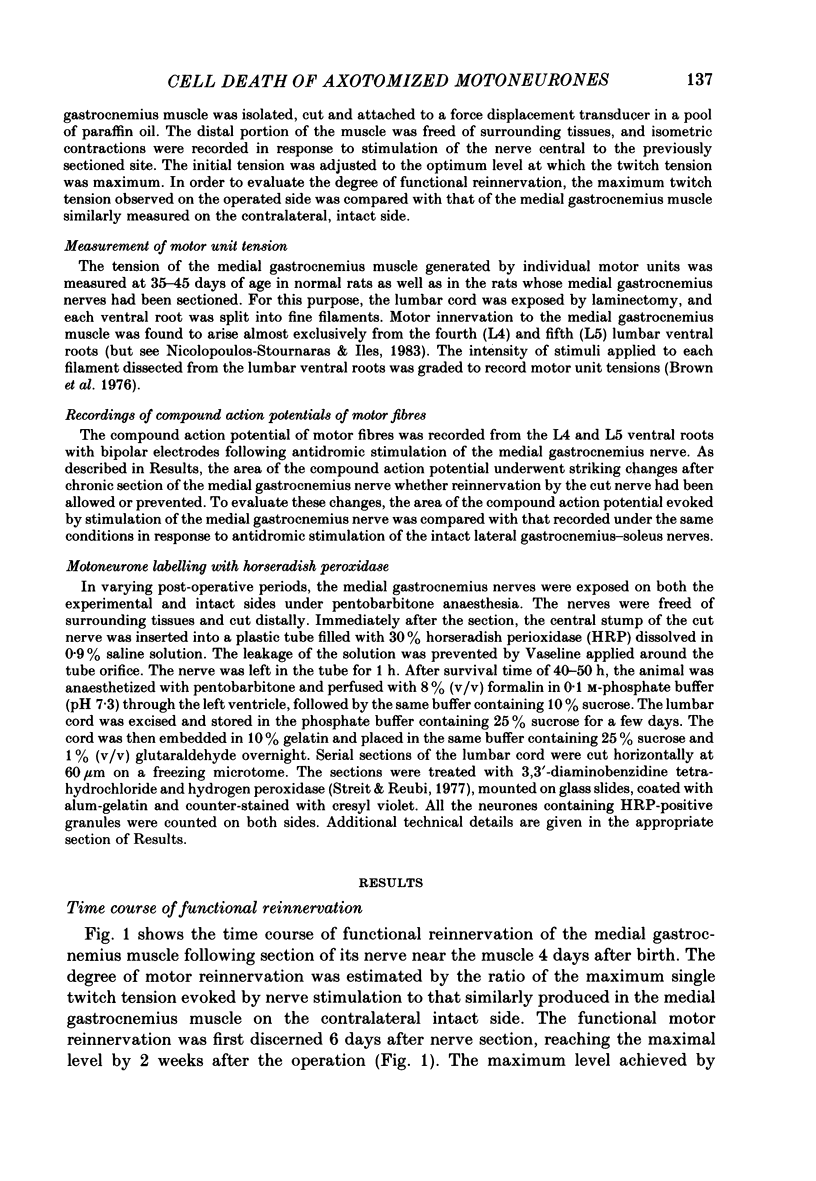

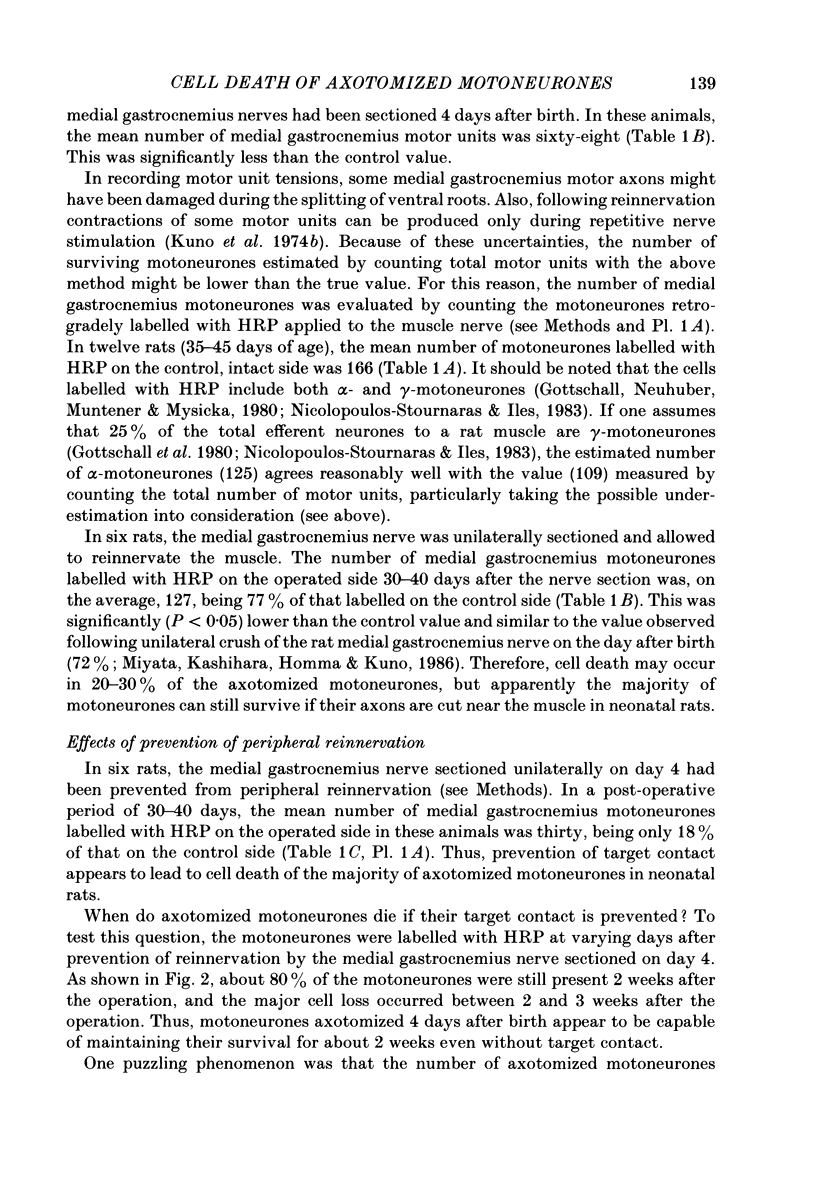
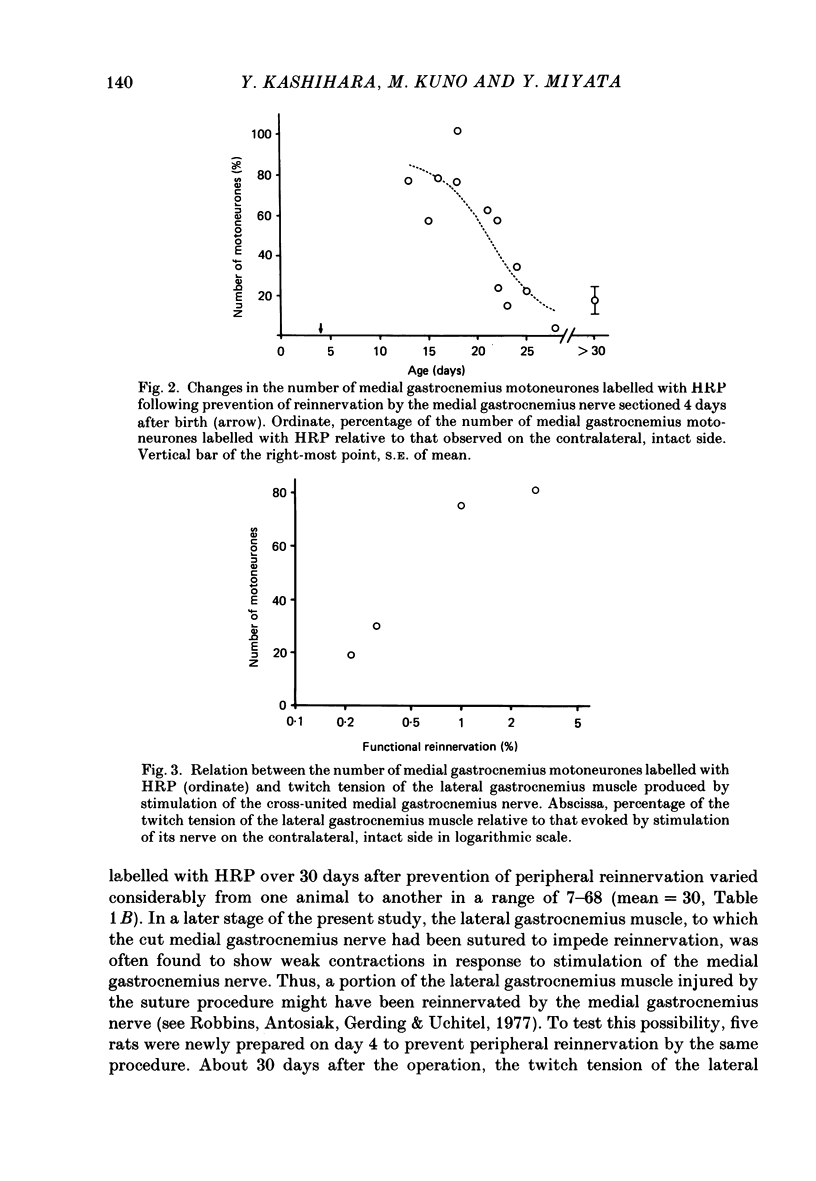
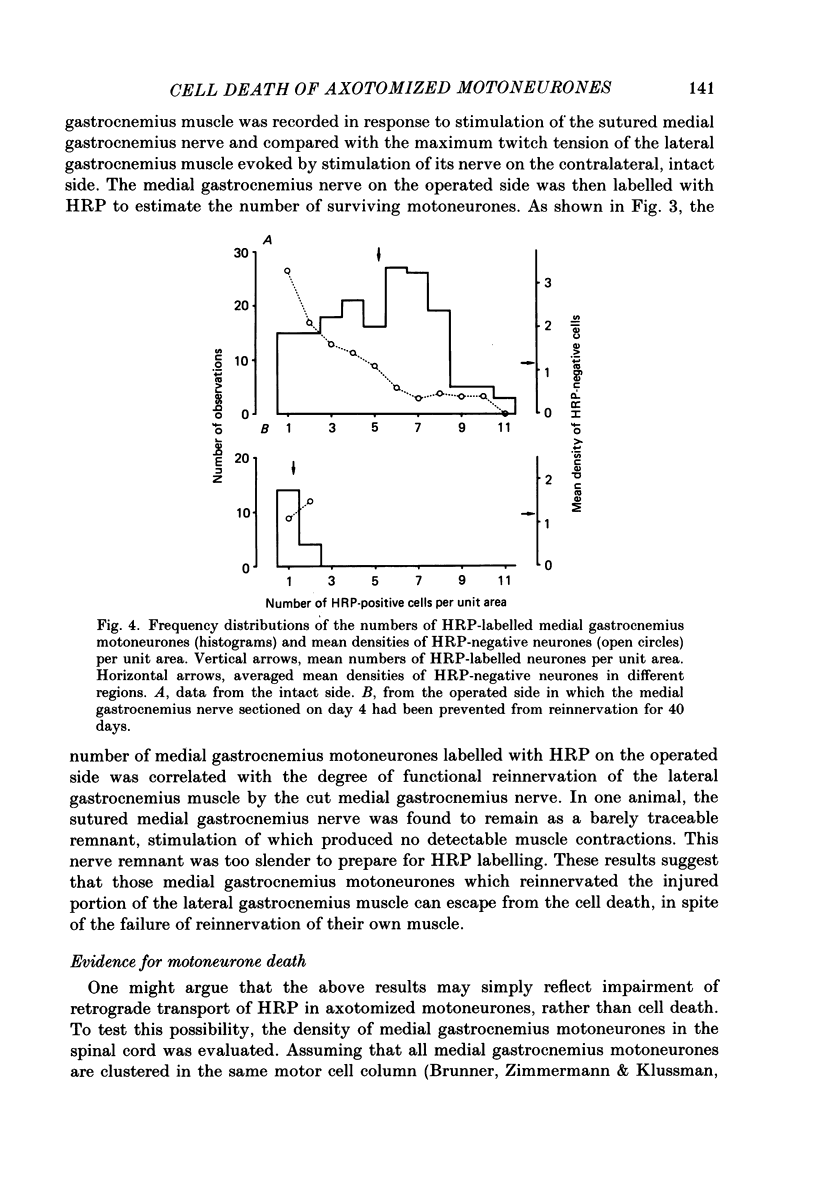
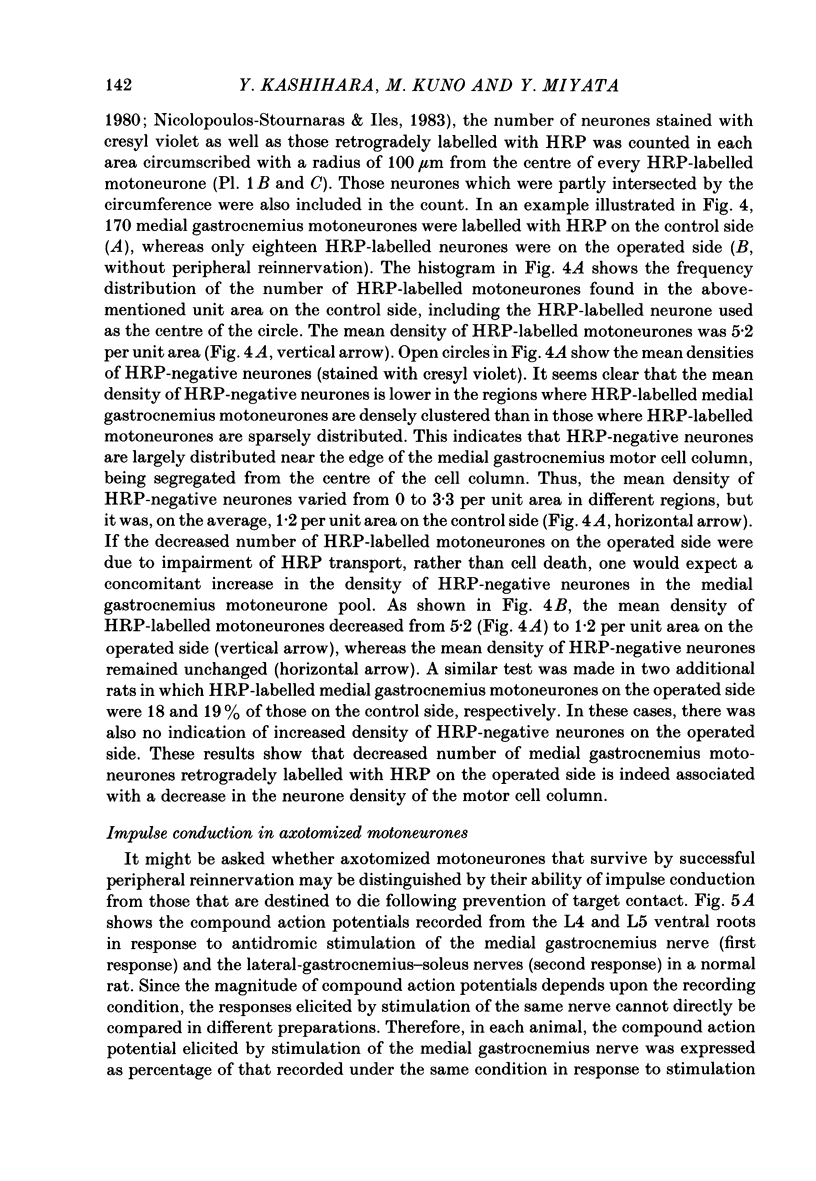
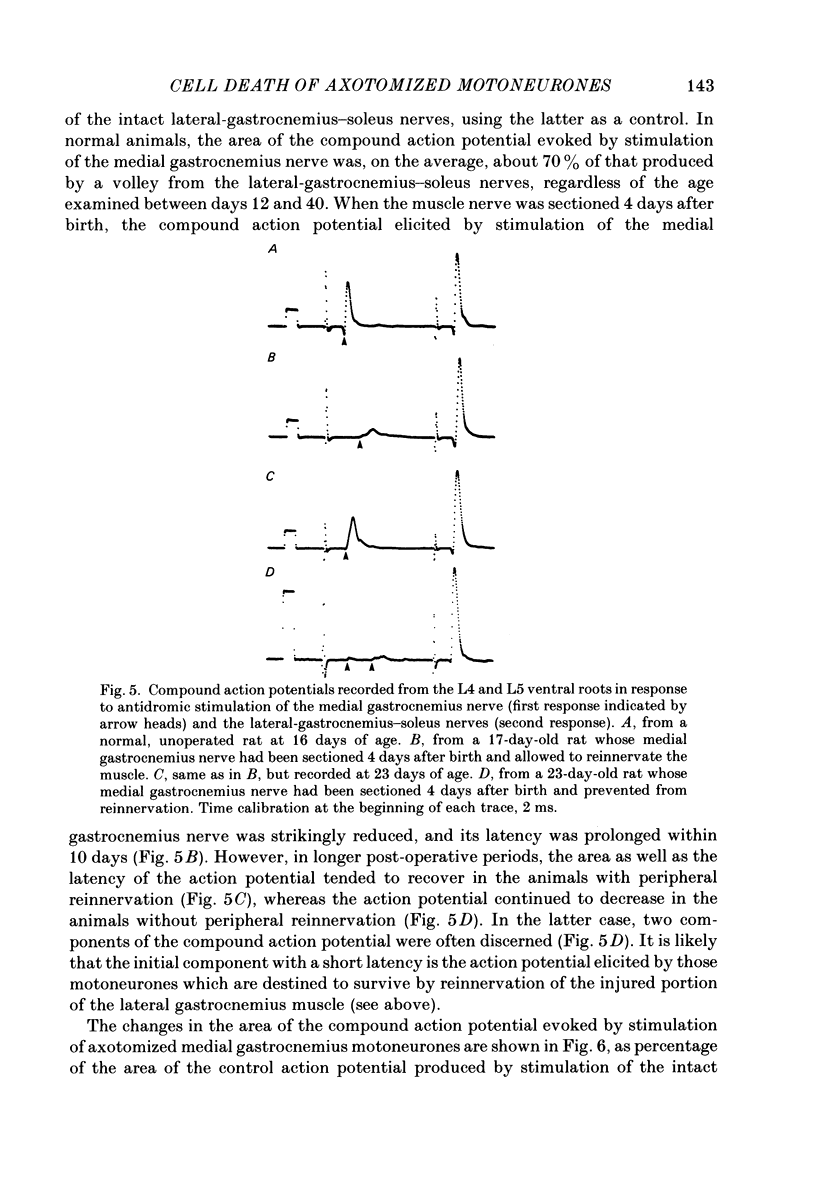

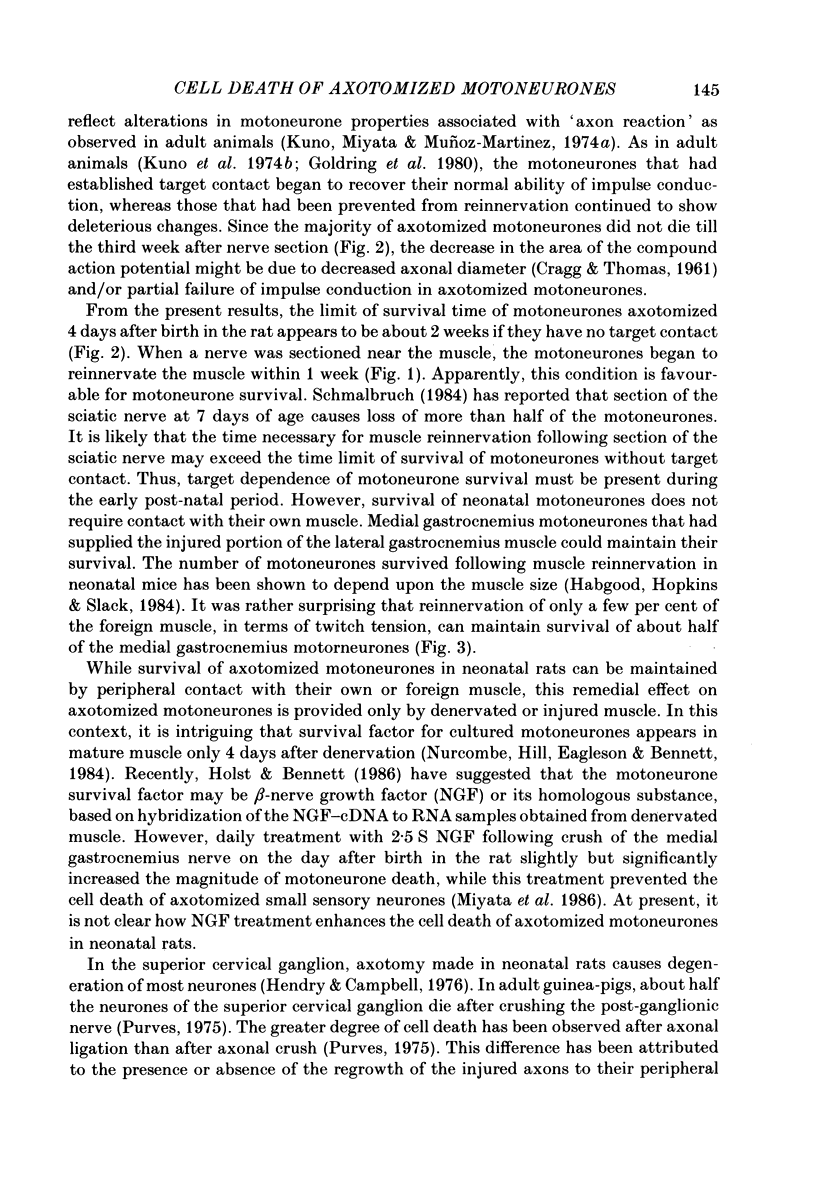

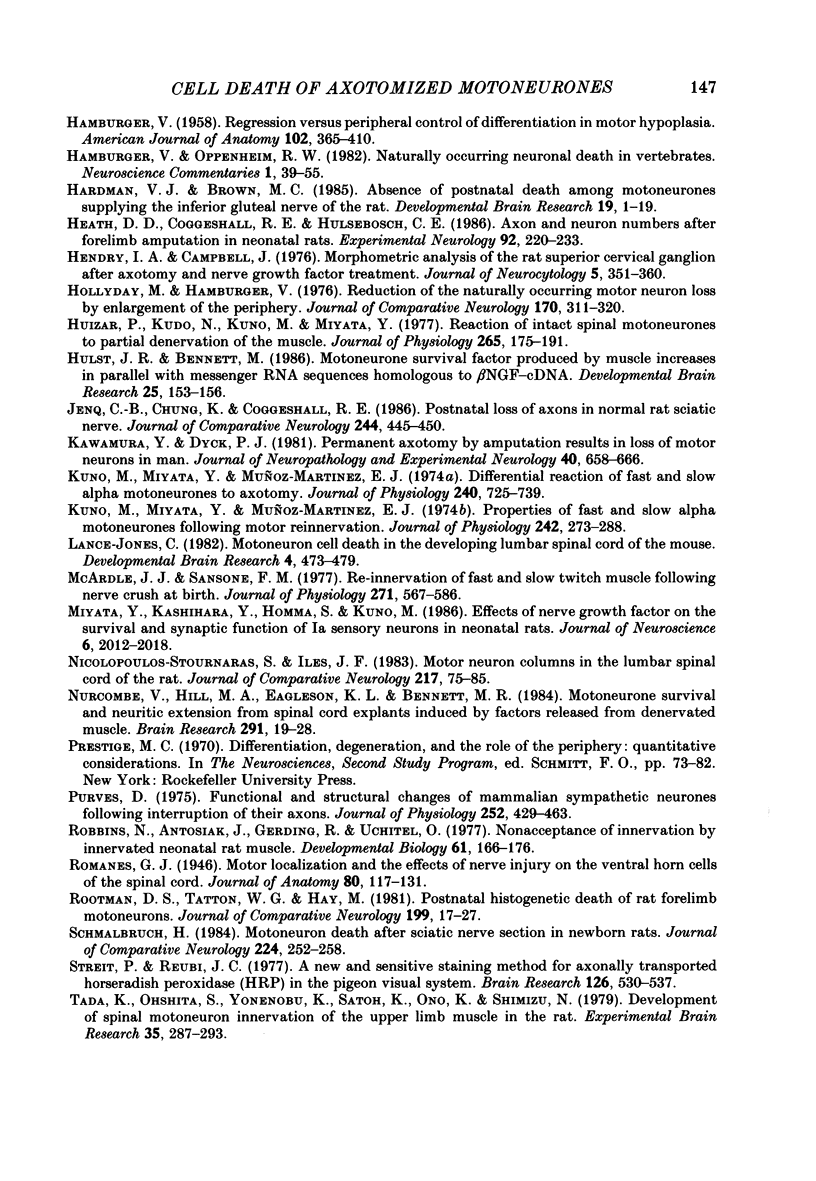

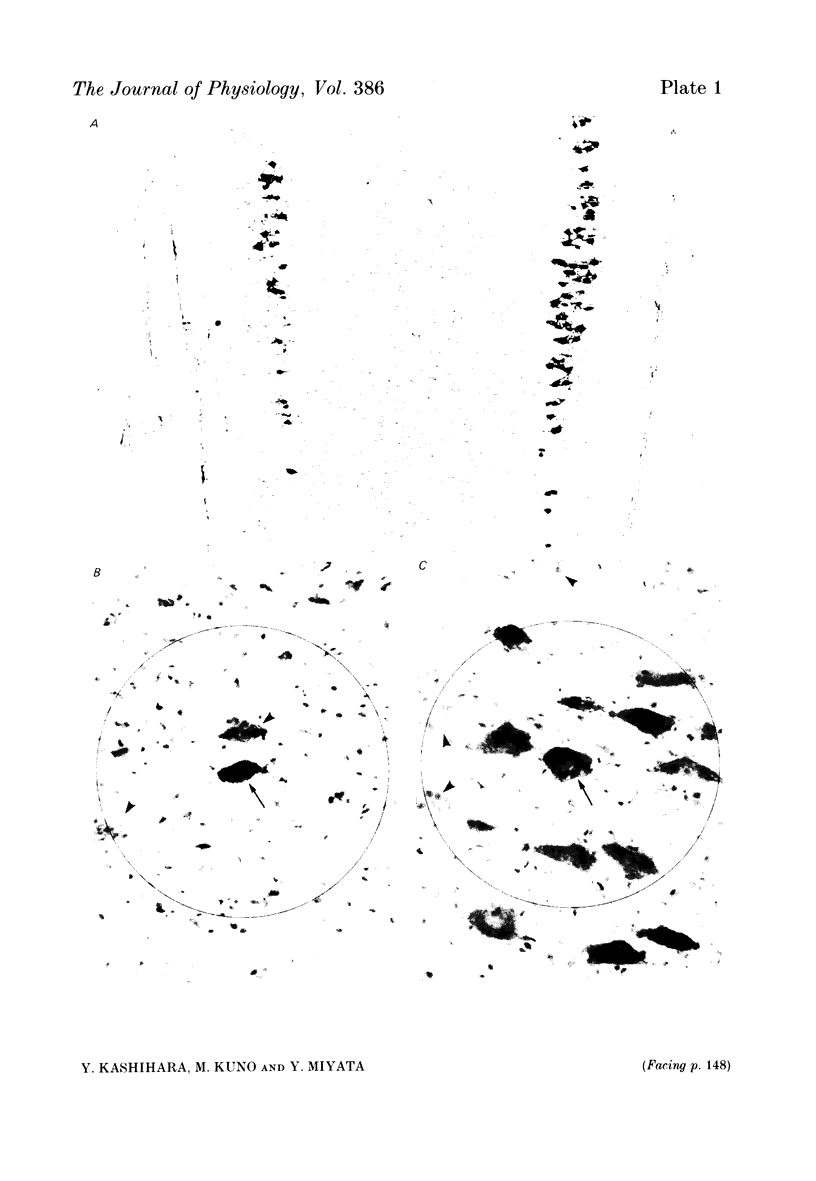
Images in this article
Selected References
These references are in PubMed. This may not be the complete list of references from this article.
- Appel S. H. A unifying hypothesis for the cause of amyotrophic lateral sclerosis, parkinsonism, and Alzheimer disease. Ann Neurol. 1981 Dec;10(6):499–505. doi: 10.1002/ana.410100602. [DOI] [PubMed] [Google Scholar]
- Baulac M., Meininger V. Postnatal development and cell death in the sciatic motor nucleus of the mouse. Exp Brain Res. 1983;50(1):107–116. doi: 10.1007/BF00238237. [DOI] [PubMed] [Google Scholar]
- Bennett M. R., McGrath P. A., Davey D. F., Hutchinson I. Death of motorneurons during the postnatal loss of polyneuronal innervation of rat muscles. J Comp Neurol. 1983 Aug 10;218(3):351–363. doi: 10.1002/cne.902180311. [DOI] [PubMed] [Google Scholar]
- Bennett M. R., Pettigrew A. G. The formation of synapses in reinnervated and cross-reinnervated striated muscle during development. J Physiol. 1974 Sep;241(2):547–573. doi: 10.1113/jphysiol.1974.sp010671. [DOI] [PMC free article] [PubMed] [Google Scholar]
- Boydston W. R., Sohal G. S. Grafting of additional periphery reduces embryonic loss of neurons. Brain Res. 1979 Dec 14;178(2-3):403–410. doi: 10.1016/0006-8993(79)90702-9. [DOI] [PubMed] [Google Scholar]
- Brown M. C., Jansen J. K., Van Essen D. Polyneuronal innervation of skeletal muscle in new-born rats and its elimination during maturation. J Physiol. 1976 Oct;261(2):387–422. doi: 10.1113/jphysiol.1976.sp011565. [DOI] [PMC free article] [PubMed] [Google Scholar]
- Brunner R., Zimmermann P., Klussmann F. W. Localization and neurophysiological properties of motoneurones of the M. triceps surae of the rat after retrograde labelling with Evans blue. Cell Tissue Res. 1980;212(1):73–81. doi: 10.1007/BF00234034. [DOI] [PubMed] [Google Scholar]
- CRAGG B. G., THOMAS P. K. Changes in conduction velocity and fibre size proximal to peripheral nerve lesions. J Physiol. 1961 Jul;157:315–327. doi: 10.1113/jphysiol.1961.sp006724. [DOI] [PMC free article] [PubMed] [Google Scholar]
- Cowan W. M., Fawcett J. W., O'Leary D. D., Stanfield B. B. Regressive events in neurogenesis. Science. 1984 Sep 21;225(4668):1258–1265. doi: 10.1126/science.6474175. [DOI] [PubMed] [Google Scholar]
- Czéh G., Gallego R., Kudo N., Kuno M. Evidence for the maintenance of motoneurone properties by muscle activity. J Physiol. 1978 Aug;281:239–252. doi: 10.1113/jphysiol.1978.sp012419. [DOI] [PMC free article] [PubMed] [Google Scholar]
- Gallego R., Kuno M., Núez R., Snider W. D. Dependence of motoneurone properties on the length of immobilized muscle. J Physiol. 1979 Jun;291:179–189. doi: 10.1113/jphysiol.1979.sp012806. [DOI] [PMC free article] [PubMed] [Google Scholar]
- Goldring J. M., Kuno M., Núez R., Snider W. D. Reaction of synapses on motoneurones to section and restoration of peripheral sensory connexions in the cat. J Physiol. 1980 Dec;309:185–198. doi: 10.1113/jphysiol.1980.sp013503. [DOI] [PMC free article] [PubMed] [Google Scholar]
- Gottschall J., Neuhuber W., Müntener M., Mysicka A. The ansa cervicalis and the infrahyoid muscles of the rat. II. Motor and sensory neurons. Anat Embryol (Berl) 1980;159(1):59–69. doi: 10.1007/BF00299255. [DOI] [PubMed] [Google Scholar]
- HAMBURGER J., RICHET G. Enseignements tirés de la pratique du rein artificiel pour l'interprétation des désordres électrolytiques de l'urémie aiguë. Rev Fr Etud Clin Biol. 1956 Jan;1(1):39–55. [PubMed] [Google Scholar]
- HAMBURGER V. Regression versus peripheral control of differentiation in motor hypoplasia. Am J Anat. 1958 May;102(3):365–409. doi: 10.1002/aja.1001020303. [DOI] [PubMed] [Google Scholar]
- Habgood M. D., Hopkins W. G., Slack J. R. Muscle size and motor unit survival in mice. J Physiol. 1984 Nov;356:303–314. doi: 10.1113/jphysiol.1984.sp015466. [DOI] [PMC free article] [PubMed] [Google Scholar]
- Hardman V. J., Brown M. C. Absence of postnatal death among motoneurones supplying the inferior gluteal nerve of the rat. Brain Res. 1985 Mar;351(1):1–9. doi: 10.1016/0165-3806(85)90225-1. [DOI] [PubMed] [Google Scholar]
- Heath D. D., 2nd, Coggeshall R. E., Hulsebosch C. E. Axon and neuron numbers after forelimb amputation in neonatal rats. Exp Neurol. 1986 Apr;92(1):220–233. doi: 10.1016/0014-4886(86)90136-6. [DOI] [PubMed] [Google Scholar]
- Hendry I. A., Campbell J. Morphometric analysis of rat superior cervical ganglion after axotomy and nerve growth factor treatment. J Neurocytol. 1976 Jun;5(3):351–360. doi: 10.1007/BF01175120. [DOI] [PubMed] [Google Scholar]
- Hollyday M., Hamburger V. Reduction of the naturally occurring motor neuron loss by enlargement of the periphery. J Comp Neurol. 1976 Dec 1;170(3):311–320. doi: 10.1002/cne.901700304. [DOI] [PubMed] [Google Scholar]
- Huizar P., Kuno M., Kudo N., Miyata Y. Reaction of intact spinal motoneurones to partial denervation of the muscle. J Physiol. 1977 Feb;265(1):175–191. doi: 10.1113/jphysiol.1977.sp011711. [DOI] [PMC free article] [PubMed] [Google Scholar]
- Hulst J. R., Bennett M. Motoneurone survival factor produced by muscle increases in parallel with messenger RNA sequences homologous to beta NGF-cDNA. Brain Res. 1986 Feb;390(1):153–156. doi: 10.1016/0165-3806(86)90164-1. [DOI] [PubMed] [Google Scholar]
- Jenq C. B., Chung K., Coggeshall R. E. Postnatal loss of axons in normal rat sciatic nerve. J Comp Neurol. 1986 Feb 22;244(4):445–450. doi: 10.1002/cne.902440404. [DOI] [PubMed] [Google Scholar]
- Kawamura Y., Dyck P. J. Permanent axotomy by amputation results in loss of motor neurons in man. J Neuropathol Exp Neurol. 1981 Nov;40(6):658–666. doi: 10.1097/00005072-198111000-00007. [DOI] [PubMed] [Google Scholar]
- Kuno M., Miyata Y., Muñoz-Martinez E. J. Differential reaction of fast and slow alpha-motoneurones to axotomy. J Physiol. 1974 Aug;240(3):725–739. doi: 10.1113/jphysiol.1974.sp010631. [DOI] [PMC free article] [PubMed] [Google Scholar]
- Kuno M., Miyata Y., Muñoz-Martinez E. J. Properties of fast and slow alpha motoneurones following motor reinnervation. J Physiol. 1974 Oct;242(1):273–288. doi: 10.1113/jphysiol.1974.sp010706. [DOI] [PMC free article] [PubMed] [Google Scholar]
- Lance-Jones C. Motoneuron cell death in the developing lumbar spinal cord of the mouse. Brain Res. 1982 Aug;256(4):473–479. doi: 10.1016/0165-3806(82)90192-4. [DOI] [PubMed] [Google Scholar]
- McArdle J. J., Sansone F. M. Re-innervation of fast and slow twitch muscle following nerve crush at birth. J Physiol. 1977 Oct;271(3):567–586. doi: 10.1113/jphysiol.1977.sp012015. [DOI] [PMC free article] [PubMed] [Google Scholar]
- Miyata Y., Kashihara Y., Homma S., Kuno M. Effects of nerve growth factor on the survival and synaptic function of Ia sensory neurons axotomized in neonatal rats. J Neurosci. 1986 Jul;6(7):2012–2018. doi: 10.1523/JNEUROSCI.06-07-02012.1986. [DOI] [PMC free article] [PubMed] [Google Scholar]
- Nicolopoulos-Stournaras S., Iles J. F. Motor neuron columns in the lumbar spinal cord of the rat. J Comp Neurol. 1983 Jun 10;217(1):75–85. doi: 10.1002/cne.902170107. [DOI] [PubMed] [Google Scholar]
- Nurcombe V., Hill M. A., Eagleson K. L., Bennett M. R. Motor neuron survival and neuritic extension from spinal cord explants induced by factors released from denervated muscle. Brain Res. 1984 Jan 16;291(1):19–28. doi: 10.1016/0006-8993(84)90646-2. [DOI] [PubMed] [Google Scholar]
- Purves D. Functional and structural changes in mammalian sympathetic neurones following interruption of their axons. J Physiol. 1975 Nov;252(2):429–463. doi: 10.1113/jphysiol.1975.sp011151. [DOI] [PMC free article] [PubMed] [Google Scholar]
- Robbins N., Antosiak J., Gerding R., Uchitel O. D. Nonacceptance of innervation by innervated neonatal rat muscle. Dev Biol. 1977 Dec;61(2):166–176. doi: 10.1016/0012-1606(77)90289-5. [DOI] [PubMed] [Google Scholar]
- Romanes G. J. Motor localization and the effects of nerve injury on the ventral horn cells of the spinal cord. J Anat. 1946 Jul;80(Pt 3):117–131. [PMC free article] [PubMed] [Google Scholar]
- Rootman D. S., Tatton W. G., Hay M. Postnatal histogenetic death of rat forelimb motoneurons. J Comp Neurol. 1981 Jun 10;199(1):17–27. doi: 10.1002/cne.901990103. [DOI] [PubMed] [Google Scholar]
- Streit P., Reubi J. C. A new and sensitive staining method for axonally transported horseradish peroxidase (HRP) in the pigeon visual system. Brain Res. 1977 May 13;126(3):530–537. doi: 10.1016/0006-8993(77)90603-5. [DOI] [PubMed] [Google Scholar]
- Tada K., Ohshita S., Yonenobu K., Ono K., Satoh K., Shimizu N. Development of spinal motoneuron innervation of the upper limb muscle in the rat. Exp Brain Res. 1979 Apr 2;35(2):287–293. doi: 10.1007/BF00236616. [DOI] [PubMed] [Google Scholar]



